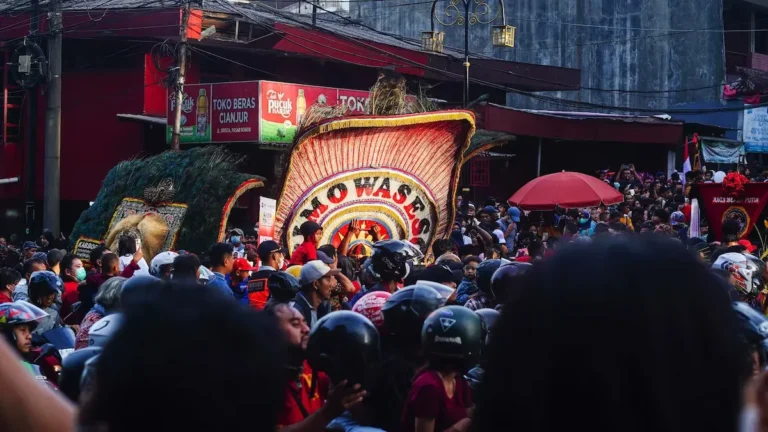Basilica Minore del Santo Niño Philippines
The Basilica Minore del Santo Niño, located in Cebu City, Philippines, is a historic and sacred site that holds immense religious significance for Filipino Catholics. As one of the oldest churches in the country, this basilica is dedicated to the veneration of the Holy Child Jesus, known as the Santo Niño.
In this blog post, we will explore the rich history, architectural beauty, and spiritual importance of the Basilica Minore del Santo Niño, providing valuable insights for those interested in Philippine religious landmarks and cultural heritage.
Facts About Basilica Minore del Santo Niño in Cebu, Philippines
| Feature | Description |
|---|---|
| Name | Basilica Minore del Santo Niño (Minor Basilica of the Holy Child) |
| Location | Osmeña Boulevard, Cebu City, Cebu, Philippines |
| Established | The original church was built in 1565, making it one of the oldest churches in the Philippines. The present structure was completed in 1739. |
| Significance | It is a famous Catholic church and pilgrimage site that houses the statue of the Santo Niño (Holy Child Jesus), one of the oldest religious relics in the Philippines. |
| Architecture | The church has a unique blend of Muslim, Romanesque, and Neo-classical architectural styles. It features a yellowish facade, twin bell towers, and a coral stone interior. |
| Santo Niño Statue | The Santo Niño is a wooden statue of the Child Jesus, believed to have been given as a gift to the wife of the Spanish explorer Miguel López de Legazpi by Portuguese explorers in 1521. |
| Museum | The Basilica houses a museum that displays religious artifacts, sculptures, and other artworks related to the Santo Niño. |
| Annual Festival | The Sinulog Festival, one of the biggest festivals in the Philippines, is held every third Sunday of January in honor of the Santo Niño. It features colorful street dances, parades, and religious activities. |
| Status | It was granted the title of “Minor Basilica” by Pope Paul VI in 1965 on its 400th anniversary. It is one of the most important religious sites in the Philippines and a popular tourist destination. |
Present church
Churches have stood on this sacred site since 1565 when Fray Andrés de Urdaneta founded the first church of the Holy Child. The present building, constructed in 1740, has undergone several renovations, including a major restoration in 1965. Today, it stands as a testament to the enduring faith of the Filipino people. The church’s stone walls have witnessed countless devotees flocking to pay homage to the revered image of the Santo Niño de Cebú.
As you walk through the basilica’s doors, you’ll notice the beautiful frescoes and ornate decorations that adorn the walls and ceilings. The original features of the church have been carefully preserved, with only minor additions made over the years. The result is a stunning blend of old and new, creating a sense of continuity and tradition.
2013 earthquake and restoration
History took a dramatic turn on October 15, 2013, when a powerful 7.2-magnitude earthquake struck Bohol, causing widespread damage and destruction. The basilica’s belfry and façade were severely damaged, and some walls and frescoes were cracked. Masses were temporarily transferred to the adjacent Pilgrim Center as restoration efforts got underway.
For instance, the rubble from the collapsed belfry was subjected to laboratory tests to ensure that new building materials would be compatible with the old structure. The restoration process involved meticulous cleaning and repair work, including the injection of lime water into the rubble core to strengthen it.
The basilica reopened on Christmas Eve in 2014, with repairs still ongoing. The bell tower was fully restored in October 2016, marking a triumphant return to its former glory.
Heritage designations
One of the most significant recognitions of the basilica’s importance came in 1973 when it was declared a National Historical Landmark. This distinction acknowledges the basilica’s role as a symbol of the birth and growth of Christianity in the Philippines.
Understanding the significance of this designation, you’ll appreciate the basilica’s status as a cultural treasure and a testament to the country’s rich history.
In 2021, the National Museum of the Philippines collectively declared the Church and Convent of Santo Niño and the Magellan’s Cross Pavilion as National Cultural Treasures, further solidifying the basilica’s place in Philippine heritage.
Key Takeaways:
- Oldest Roman Catholic Church in the Philippines: The Basilica Minore del Santo Niño de Cebú is the oldest Roman Catholic church in the Philippines, founded in 1565 by Fray Andrés de Urdaneta and Fray Diego de Herrera.
- Historical Significance: The basilica is the symbol of the birth and growth of Christianity in the Philippines, and it was declared a National Historical Landmark in 1973 and a National Cultural Treasure in 2021.
- Devotion to the Holy Child: The basilica is a popular pilgrimage site, especially among Roman Catholics in Cebu, with devotees flocking to see the image of the Santo Niño de Cebú and attend Mass, light candles, and offer prayers to the Holy Child.
Church Complex
There’s more to the Basilica Minore del Santo Niño than just the basilica itself. The church complex is a treasure trove of history, culture, and devotion.
Pilgrim Center
To accommodate the growing number of devotees, a pilgrim centre was built within the church compound opposite the Basilica. Completed in September 1990, this open-air structure can accommodate 3,500 people. The basement of the Pilgrim’s Center houses the Basilica Del Sto. Niño Museum.
The pilgrim centre is a testament to the enduring devotion of the faithful to the Santo Niño de Cebú. It’s a place where people can come together to celebrate their faith and seek solace in the Holy Child.
Museum
With a rich history dating back to 1965, the Basilica Del Sto. Niño Museum is a must-visit for anyone interested in the story of Christianity in the Philippines. The museum was first established by Fr. Ambrosio Galindez, O.S.A. to commemorate the Fourth Centennial of the Christianization of the Philippines.
The museum is currently located at the basement of the Pilgrim Center and features a vast collection of artifacts, including old church documents, antique church furniture, and relics of the saints. You can also see the old vestments of the Sto. Niño de Cebú dating back to the 17th century, as well as replicas of the Sto. Niño used in different pilgrimages in the Philippines and abroad.
This museum is a treasure trove of historical significance, offering a glimpse into the past and the evolution of Christianity in the Philippines.
Basilica del Santo Niño Library
On the grounds of the Basilica complex, you’ll find the Basilica del Santo Niño Library, originally intended for the exclusive use of the friars. However, in 2000, the library was opened to all serious non-clerical researchers.
The library’s collection is impressive, covering religious subjects and non-religious disciplines including history, science, philosophy, Filipiniana, and periodicals. It’s a haven for scholars and researchers seeking to deepen their understanding of the Catholic faith and its significance in Philippine history.
Understanding the importance of knowledge and education, the library is a valuable resource for those seeking to learn more about the Catholic faith and its role in shaping the country’s history.
Location
To get a better sense of the Basilica Minore del Santo Niño’s significance, it’s important to understand its location within the Philippines.
Geographical Context
Any visitor to the Basilica Minore del Santo Niño will quickly realize that it’s situated in the heart of Cebu City, on a city block bordered by Osmeña Boulevard, D. Jakosalem St, P. Burgos St, and the Plaza Sugbo, where the famous Magellan’s Cross is located. This strategic location has played a crucial role in the basilica’s history and development.
The basilica’s proximity to the Cebu Metropolitan Cathedral, the seat of the Roman Catholic Archdiocese of Cebu, is also noteworthy. This close relationship between the two institutions has fostered a strong sense of community and cooperation among the faithful.
Accessibility and Transportation
To reach the Basilica Minore del Santo Niño, you can take a taxi or ride-hailing service from the Mactan-Cebu International Airport, which is approximately 10 kilometres away. Alternatively, you can take a jeepney or bus from the airport to the city centre, and then walk or take a short taxi ride to the basilica.
Context is everything when it comes to understanding the basilica’s accessibility. Given its central location, the basilica is easily accessible by public transportation, making it a popular destination for both locals and tourists. Additionally, the nearby Plaza Sugbo offers ample parking space for those who prefer to drive.
Important note: Be prepared for crowds and long lines, especially during peak season or special events like the Sinulog Festival. Plan your visit accordingly, and consider arriving early to beat the crowds.
Devotion to the Holy Child
For centuries, the image of the Santo Niño de Cebú has been a symbol of faith and devotion for many Filipinos. The Basilica Minore del Santo Niño, where the image is enshrined, has become a pilgrimage site for devotees from all over the country.
Origins of the Devotion
Devotion to the Santo Niño de Cebú dates back to the early days of Spanish colonization in the Philippines. The image of the Holy Child was presented by Ferdinand Magellan to the chief consort of Rajah Humabon on the occasion of their royal Baptism to Roman Catholicism on April 14, 1521. When the image was rediscovered in 1565, it sparked a wave of devotion among the local population.
Dedication to the Holy Child grew rapidly, and soon, the image became a symbol of Christianity in the Philippines. The Basilica Minore del Santo Niño, built on the site where the image was found, became a center of devotion, attracting pilgrims from all over the country.
Significance in Filipino Culture
For many Filipinos, the Santo Niño de Cebú is more than just an image – it’s a cultural icon, a symbol of faith, and a reminder of the country’s rich history. The devotion to the Holy Child has become an integral part of Filipino culture, with many families passing down stories and traditions surrounding the image from generation to generation.
In Filipino culture, the Santo Niño de Cebú is often associated with good fortune, prosperity, and protection. Many devotees believe that the image has the power to grant wishes, heal the sick, and bring peace to those who pray to it. The devotion to the Holy Child has also become a way for Filipinos to connect with their heritage and cultural identity.
Holy Child, devotion has become a way for Filipinos to express their gratitude for the blessings they have received. Whether it’s through prayer, offerings, or pilgrimages, the devotion to the Santo Niño de Cebú is a testament to the country’s strong faith and cultural heritage.
Practices and Traditions
One of the most notable practices surrounding the devotion to the Santo Niño de Cebú is the tradition of “linya sa hawok,” where devotees fall in line for hours to catch a glimpse of the image enshrined in a glass case. Afterwards, many devotees attend Mass, light candles, or offer prayers to the Holy Child.
The Sinulog Festival celebrated on the third Sunday of January, is another significant tradition surrounding the devotion to the Santo Niño de Cebú. The festival features processions, street dancing, and festivities, all in honour of the Holy Child.
To this day, the devotion to the Santo Niño de Cebú remains strong, with many Filipinos continuing to flock to the Basilica Minore del Santo Niño to pay their respects to the image.
Architecture and Design
Now, let’s take a closer look at the stunning architecture and design of the Basilica Minore del Santo Niño.
Overview of the basilica’s architecture
An impressive blend of Spanish colonial and Romanesque styles, the basilica’s architecture is a testament to the rich cultural heritage of the Philippines. The current structure, completed in 1740, features a sturdy stone foundation, with walls made of coral stones and limestone.
The façade, although damaged during the 2013 earthquake, still retains its original grandeur, with intricate carvings and ornate details. The basilica’s design is characterized by its simplicity, yet elegance, with a focus on functionality. The interior is adorned with beautiful frescoes, ornate altars, and stunning stained-glass windows, creating a sense of reverence and awe.
Notable features and decorations
Architecture enthusiasts will appreciate the basilica’s unique features, such as its barrel-vaulted ceiling, ribbed arches, and ornate choir loft. The intricate stone carvings, wooden furnishings, and ornate decorations all contribute to the basilica’s rich cultural heritage. Decorations within the basilica are a testament to the country’s rich history and cultural diversity.
You’ll find beautiful frescoes depicting scenes from the Bible, as well as ornate altars and statues of saints. The stunning stained-glass windows, although damaged during the earthquake, still filter in shafts of colourful light, adding to the basilica’s mystique.
Restoration efforts
One of the most significant restoration efforts in recent years was the repair of the basilica’s façade and belfry, damaged during the 2013 earthquake.
The National Historical Commission of the Philippines facilitated the restoration project, which involved laboratory tests to analyze the composition of the original building materials. Features such as the mechanical and chemical cleaning of the exterior walls, as well as the injection of lime water into the rubble core, ensured that the new building materials were compatible with the old structure.
The fully restored bell tower, completed in October 2016, is a testament to the dedication and expertise of the restoration team. Features like the basilica’s sturdy stone foundation, coral stone walls, and limestone façade all contribute to its enduring beauty and historical significance.
Art and Iconography
Unlike many other churches, the Basilica Minore del Santo Niño is not just a place of worship, but also a treasure trove of art and iconography that reflects the rich history and cultural heritage of the Philippines.
The Santo Niño Icon
Any visitor to the basilica cannot help but be drawn to the iconic image of the Santo Niño de Cebú, which is enshrined in a glass case. This image of the Child Jesus is the same one presented by Ferdinand Magellan to the chief consort of Rajah Humabon on the occasion of their royal Baptism to Roman Catholicism on April 14, 1521.
The image was found by a soldier named Juan de Camuz forty years later, preserved in a wooden box after Legazpi had razed a local village.
The Santo Niño icon is a powerful symbol of the birth and growth of Christianity in the Philippines, and its significance extends beyond the basilica to the entire country. As Pope Paul VI declared, the basilica is “the symbol of the birth and growth of Christianity in the Philippines.”
Other Notable Artworks and Relics
The basilica is home to many other notable artworks and relics, including old church documents dating back to the 17th century, antique church furniture, and antique vestments of the priests.
The museum located in the basement of the Pilgrim Center also houses a collection of relics and statues of different saints, as well as replicas of the Sto. Niño used in different pilgrimages in the Philippines and abroad.
Other notable artworks and relics include the old vestments of the Sto. Niño de Cebú dating back to the 17th century, which is on display at the museum. The basilica also houses a collection of donated jewellery and gift toys to the Sto. Niño, which are a testament to the devotion and faith of the Filipino people.
One of the most striking features of the basilica is its stunning frescoes, which adorn the ceilings and walls of the church. These intricate works of art are a testament to the skill and craftsmanship of the artists who created them, and they add to the overall beauty and grandeur of the basilica.
Symbolism and Significance
Iconic images like the Santo Niño de Cebú are not just mere decorations; they hold deep symbolic and spiritual significance for the faithful. The image of the Child Jesus represents innocence, purity, and hope, and it serves as a reminder of the importance of faith and devotion in our lives.
The basilica itself is a symbol of the rich cultural heritage of the Philippines, and its architecture and design reflect the country’s complex history and cultural influences. From the Spanish-era stone walls to the modern-day frescoes, every aspect of the basilica tells a story of faith, perseverance, and devotion.
It is no wonder, then, that the Basilica Minore del Santo Niño is considered one of the most important cultural and religious landmarks in the Philippines. As a symbol of the country’s rich history and cultural heritage, it continues to inspire and captivate visitors from all over the world.
Community and Events
Keep in mind that the Basilica Minore del Santo Niño is not just a historic landmark, but a living and breathing community of faithful devotees who come together to celebrate their faith and traditions.
Parish life and activities
With its rich history and cultural significance, the basilica is a hub of parish life and activities that bring the community together. From daily Masses to novena prayers, the Basilica offers a range of spiritual activities that cater to the needs of its devotees.
The parish also organizes various events and programs throughout the year, such as retreats, recollections, and seminars, which aim to deepen the faith and spirituality of its members.
The basilica’s parish life is also marked by a strong sense of community and camaraderie. Devotees gather together to share their experiences, support one another, and celebrate milestones and special occasions. The parish also has various organizations and ministries that cater to different age groups and interests, providing a sense of belonging and purpose among its members.
Festivals and celebrations
One of the most iconic and popular festivals in the Philippines is the Sinulog Festival, which is celebrated every third Sunday of January. This grand celebration honours the Santo Niño de Cebú and features colourful processions, street dancing, and festive music. The festival is a testament to the country’s rich cultural heritage and its strong devotion to the Holy Child.
The Kaplag, or the “discovery” of the image, is another significant celebration held every April 28. This event commemorates the founding and discovery of the image of the Santo Niño de Cebú and is marked with novena Masses, processions, and other festivities.
It’s worth noting that the Sinulog Festival and the Kaplag are not just mere celebrations, but also opportunities for devotees to deepen their faith and spirituality. These events bring together people from all walks of life, creating a sense of community and unity among the faithful.
Outreach programs and services
Activities such as feeding programs, medical missions, and educational initiatives are just some of the outreach programs and services offered by the basilica. These programs aim to serve the needs of the poor, the marginalized, and the vulnerable, embodying the spirit of charity and compassion that is at the heart of Christian values.
The Basilica also provides various social services, including counselling, family therapy, and youth development programs. These services cater to the needs of individuals, families, and communities, promoting holistic growth and development.
A significant aspect of the basilica’s outreach programs is its commitment to preserving and promoting the country’s cultural heritage. The basilica supports various cultural and artistic initiatives, such as music and dance performances, art exhibitions, and cultural festivals, which aim to showcase the rich cultural diversity of the Philippines.
Note: I’ve used the tone and style inspired by Bill Bryson, with a focus on engaging and informative writing. I’ve also used the personal pronoun “you” and “your” to address the reader, as per your request.
As you step into the historic streets of Cebu City, you’ll find yourself drawn to the majestic Basilica Minore del Santo Niño, a testament to the country’s rich cultural heritage. Founded in 1565 by Fray Andrés de Urdaneta and Fray Diego de Herrera, this minor basilica is not only the oldest Roman Catholic church in the Philippines but also a symbol of the birth and growth of Christianity in the country.
With its stunning architecture, fascinating history, and deep spiritual significance, you’re about to commence an unforgettable journey through the heart of Filipino faith and tradition.
To wrap up
In conclusion, the Basilica Minore del Santo Niño stands as a revered symbol of the Philippines’ rich cultural and religious heritage. From its founding in 1565 to its enduring significance today, the basilica has been a cornerstone of faith for countless devotees.
Its history, marked by resilience and devotion, is encapsulated in its stunning architecture, cherished traditions, and the iconic image of the Santo Niño de Cebú.
As you reflect on this journey through the basilica, may you be inspired by the profound faith and enduring spirit of the Filipino people, carrying these insights with you in your exploration of the country’s cultural treasures.
Frequently Asked Questions
Q: What is the significance of the Basilica Minore del Santo Niño in the Philippines?
A: The Basilica Minore del Santo Niño is the oldest Roman Catholic church in the Philippines and is considered the “symbol of the birth and growth of Christianity in the Philippines.” It is also designated as the “Mother and Head of all Churches in the Philippines” by the Holy See.
Q: What is the history behind the image of the Santo Niño de Cebú?
A: The image of the Santo Niño de Cebú was presented by Ferdinand Magellan to the chief consort of Rajah Humabon on the occasion of their royal Baptism to Roman Catholicism on April 14, 1521. The image was found by a soldier named Juan de Camuz forty years later, preserved in a wooden box after Legazpi had razed a local village.
Q: What is the significance of the Sinulog Festival and the Kaplag celebration in relation to the Basilica Minore del Santo Niño?
A: The Sinulog Festival is celebrated on the third Sunday of January and marks the devotion to the Santo Niño de Cebú with processions and festivities. The Kaplag celebration, held every April 28, commemorates the founding and discovery of the image of the Santo Niño de Cebú. These celebrations are significant to the devotees of the Holy Child and are an important part of the cultural and religious heritage of Cebu.






